The Bazaars of Istanbul101: Discover Centuries-Old Market Captivating Traditions

Updated On: April 17, 2024 by Fatma Mohamed
The Bazaars of Istanbul teem with the liveliness and colour that befit their ancient heritage. In these markets, we find not just the mundane transactions of commerce but centuries of history, culture, and intricate craftsmanship passed down through generations. Istanbul’s bazaars offer a maze of experiences, a place where tales of merchants, travellers, and curious locals intertwine. Each corner of these markets is drenched in stories that echo a thousand years, providing a remarkably immersive insight into the city’s enduring legacy.
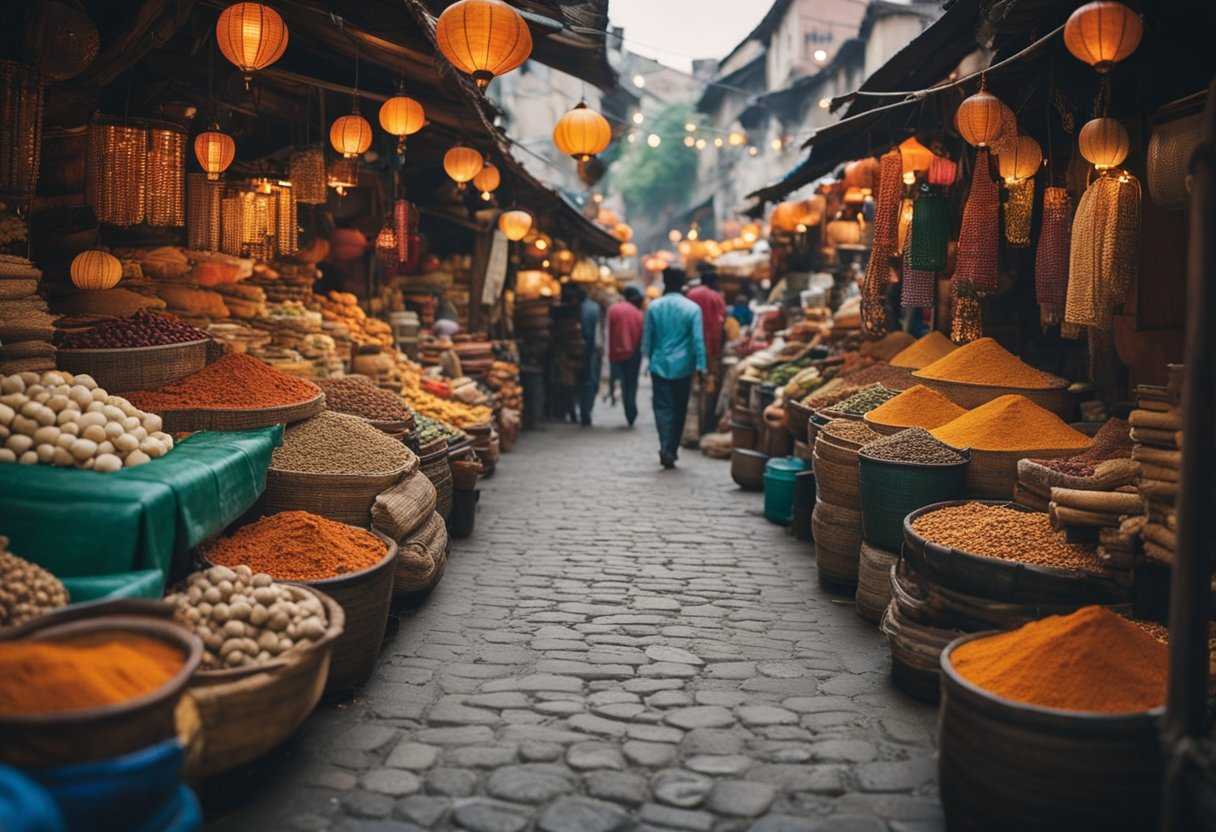
Navigating through the labyrinthine alleys of Istanbul’s bazaars is like walking back in time. The architectural feats, from vaulted passageways to intricately designed fountains, reflect a time when these marketplaces were not just centres for trade but significant social hubs. Today, the love reverberates in the call of vendors, in the diversity of the goods – from culinary delights to rare second-hand treasures – and in the art of negotiation, which remains a vibrant part of the shopping experience. These bazaars are not just about shopping; they are a celebration of Istanbul’s local culture and a testament to its ability to adapt and thrive through the ages.
Table of Contents
Bazaars of Istanbul: The History and Heritage
Istanbul’s bazaars, especially the iconic Grand Bazaar, are a mosaic of the city’s rich past, unfolding from Byzantine times through Ottoman rule and resonating with stories of commerce and culture that have thrived across centuries.
Byzantine Beginnings and Ottoman Expansion
Before the arrival of the Ottomans, the Byzantine period witnessed Istanbul’s early market activity. The city, known then as Constantinople, was a bustling hub of trade where local and foreign merchants exchanged goods. It is our Ottoman successors, however, who left a formidable imprint on Istanbul’s commercial landscape. Following the Ottoman conquest of Constantinople in 1453, a new era dawned for the bazaars. Sultan Mehmed II, often referred to as Sultan Mehmet Conquer, initiated the construction of an edifice that would become the heart of Istanbul’s trade: the Grand Bazaar. This monumental project began during the winter of 1455/56, not only to stimulate the economy but also to solidify the Ottoman Empire‘s might.

From the 15th Century to Modern Day
From its inception in the 15th century, the Grand Bazaar has evolved significantly. It expanded into a labyrinth of vaulted passageways and over 4,000 shops, becoming the pivotal centre for merchants from all over the empire. The bazaar fostered a diverse retail environment, where silk, spices, jewellery, and myriad other goods exchanged hands. It was a place where heritage and commerce coalesced, defining the character of Istanbul as a city at the crossroads of continents.
Today, the Grand Bazaar endures not just as one of the world’s oldest and largest covered markets but as a living testament to Istanbul’s history, attracting hundreds of thousands of visitors who walk its corridors daily, basking in the heritage of a marketplace that has spanned several centuries.
Architectural Wonders of Istanbul’s Markets

Istanbul’s markets are not just commercial hubs but also architectural masterpieces that narrate the city’s rich history. Each market from the Grand Bazaar to the smaller yet significant markets around the city showcase unique aspects of Istanbul’s urban fabric and its evolution over centuries.
Grand Bazaar’s Design

At the heart of Istanbul’s historic peninsula lies the Grand Bazaar, known as Kapalı Çarşı in Turkish. This sprawling market, nestled between the Nuruosmaniye Gate and Beyazit, encompasses a vast network of lanes, each infinitely rich in detail. A visitor to the Grand Bazaar experiences a stunning array of domes and vaults intertwining above, casting shadows that play with the light filtering in. The market’s structure boasts 61 covered streets, houses, and over 4,000 shops, further accentuating the grandeur of traditional Ottoman architecture.
Notably, the market’s layout, although appearing as a maze-like puzzle, was meticulously planned to streamline the flow of goods and services. Each section historically specialized in particular trades, reflected in the names of the streets, such as Goldsmiths’ Street and Carpet Sellers’ Street. The Grand Bazaar’s design is not just a product of its era; it is a living, breathing organism that has adapted to the changing needs of Istanbul and its people.
Distinct Features of Other Historic Markets

Adjacent to iconic landmarks like the Blue Mosque and Sultanahmet, other historic markets embellish Istanbul’s architectural canvas. The Spice Bazaar, also known as the Egyptian Bazaar, situated in Eminonu, is famous for its L-shaped building topped with a multitude of domes. This market, infused with the aroma of herbs and spices, forms a vibrant tapestry of colours and textures.
The Arasta Bazaar, near the Sultanahmet area, although smaller than the Grand Bazaar, holds its ground with elegant shop fronts and a less frantic ambience. Another market of note includes the Sahaflar Çarşısı, a charming antique book bazaar with a storied past located next to the Beyazit Mosque.
Meanwhile, the New Mosque (Yeni Cami) watches over the hustle and bustle of market life in the vicinity, merging religious and commercial life in a harmonious ensemble. Each of these markets contributes distinct architectural features to Istanbul, from courtyards bathed in sunlight to intricate latticework that whispers tales of a bygone era.
Culinary Treasures and Delicacies
In the heart of Istanbul, the bazaars are a vibrant showcase of Turkish gastronomy, presenting a dazzling array of culinary treasures. Our journey discovers the very ingredients that are central to traditional Turkish cuisine.
Spices and Herbs of Istanbul

The Spice Bazaar, or Mısır Çarşısı, is a sensory haven where the rich fragrance of spices fills the air. Here, one finds staples such as sumac, saffron, and mint. These spices and herbs add depth and complexity to Turkish dishes and are essential to recreating authentic flavours. Istanbul’s markets stand as testimony to Türkiye‘s love affair with condiments, where each stall presents a kaleidoscope of options for both locals and travellers to explore.
The Savour of Fresh Produce and Street Food
As we meander through Istanbul’s markets, the abundance of fresh produce is unmistakable. Juicy tomatoes, crisp cucumbers, and plump fruit are basics in Turkish cuisine, often finding their way into colourful salads and side dishes. The street food scene provides a taste of Istanbul on the go with delectable kebabs and simit, tempting passersby with their delightful aromas. Istanbul’s dedication to fresh ingredients is clear, delivering taste sensations that speak of tradition and the city’s culinary prowess.
Shopping in Istanbul: A Diverse Experience

Embarking on a shopping expedition in Istanbul is to wander through a mosaic of history and commerce. Every bazaar and shop offers a slice of a civilisation that has perfected the art of trading over centuries.
Textiles and Clothing
Istanbul’s markets are world-renowned for their wide array of exquisite textiles. One can find everything from luxurious silks to richly embroidered fabrics. Among these, the Grand Bazaar stands out, its labyrinthine alleys lined with shops selling a mesmerising selection of garments ranging from traditional Turkish outfits to contemporary fashion. Quality leather coats and accessories are also abundant, reflecting the city’s historic craftsmanship.
Visitors hunting for something truly unique gravitate towards the stunning gold and silver jewellery, often handcrafted with intricate designs that whisper stories of a bygone era. The skilled local jewellers offer personalisation, turning a simple shopping trip into a journey of discovery.
Souvenirs and Handcrafted Goods

The bazaars of Istanbul transform a customary shopping trip into an exploration of culture and craftsmanship. As you stroll these ancient marketplaces, it’s easy to get enchanted by the array of souvenirs that reflect the spirit of the city. From delicate ceramics and vibrant glass lamps to hand-painted tiles, each piece serves as a tangible memory of the journey.
In particular, the Spice Bazaar provides a spectacular array of spices that create a tapestry of colours and fragrances, beckoning those who seek to take home the flavours of Istanbul.
But perhaps no other item captures the essence of Turkish heritage as marvellously as the handwoven carpets. The intricate patterns and vivid hues embody centuries of tradition and are often considered a crown jewel for collectors and interior designers alike. Each pattern tells a tale, and each knot is a testament to the weaver’s expertise — making them not just purchases but heirlooms.
The Art of Negotiation in Marketplaces
The bustling bazaars of Istanbul are more than just shopping destinations; they’re a hub where the Turkish art of haggling showcases a tradition sprawling across centuries. This practice is not simply about getting the best price; it’s a dance of words and gestures deeply ingrained in the local culture.
Haggling Culture
In our journey through Istanbul’s markets, we observe that to haggle is to partake in an authentic Turkish tradition. Merchants expect it, and tourists who do not engage may indeed pay more than the local rate. Beginning with a friendly greeting, negotiators here use a blend of flattery, humour, and patience.

A typical exchange might unfold over a glass of çay – the traditional Turkish tea – as both parties discuss the price amidst casual conversation. The starting price set by vendors is often inflated, with the understanding that it will be lowered following the haggling process. To participate effectively in this cultural experience, one must understand the subtle cues and know when to exert pressure and when to concede.
The outcome of negotiation can lead to genuine bargains, but it’s also about the experience itself—connecting with local traders, sharing stories, and often, leaving with a piece of treasured craftsmanship. We advise shoppers to respect the tradition, enjoy the banter, and remember that a successful haggle ends with both sides satisfied.
This time-honoured trading style ensures the vitality of the Grand Bazaar, ensuring each purchase carries with it a story—a memento not just of goods but of a shared moment in time between visitor and vendor.
Experiencing the Local Culture and Traditions
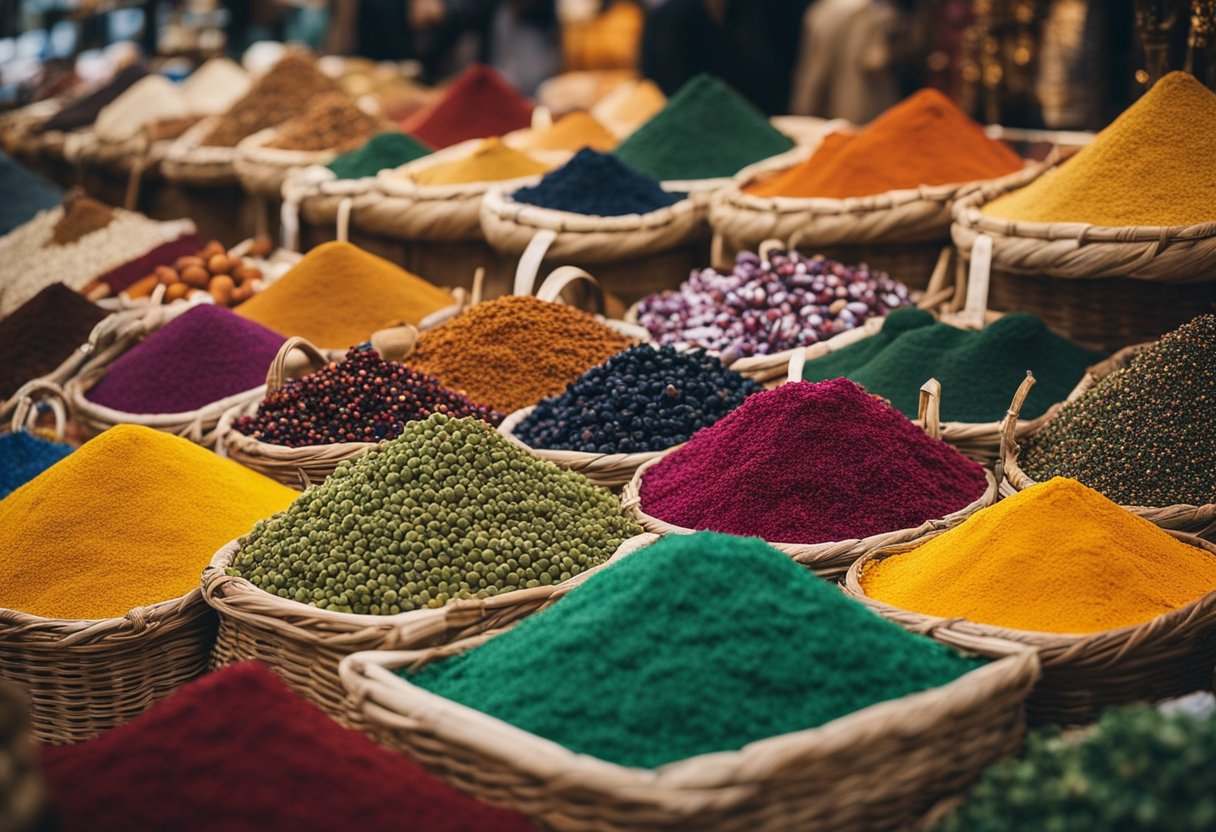
Istanbul’s bazaars are not just markets; they are timeless hubs where you can immerse yourself in Turkish culture and traditions. Each bazaar has a unique atmosphere, but they all celebrate the intricate craftsmanship and vibrant cultural presence that Turkey is renowned for.
Craftsmanship and Artistry
Visitors to Istanbul’s bazaars are greeted by an array of authentic Turkish souvenirs ranging from handmade ceramics to intricately woven kilims. The craftsmanship here is a testament to centuries-old techniques that have been passed down through generations. You can observe artisans at work, carving, weaving, or painting, honouring their heritage in every piece they create. The Grand Bazaar, with its labyrinth of lanes, hosts a multitude of shops where these traditional crafts are not just sold but brought to life.
- Ceramics: These often feature intricate Iznik motifs and tell stories of Türkiye’s artistic past.
- Kilim Rugs: Every pattern holds a meaning, a language without words that speaks of tradition and history.
Musical and Cultural Presence in Bazaars
The air in Istanbul’s bazaars is often filled with the sound of traditional Turkish music, echoing from ouds and neys, creating an atmosphere that is as enchanting as the historical ambience itself. Strolling through markets like Istiklal Street, visitors experience the city’s modern vibrancy amidst preserved tradition, where street musicians add a soundtrack to the bustling scenes of commerce and community.
- Old Books and Antiques: Markets like the Ferikoy Antique Market are treasure troves for bibliophiles and collectors, offering rare finds and memories etched in time.
- Cultural Events: Various bazaars also play host to cultural events, uniting locals and travellers in a celebration of Istanbul’s living traditions.
In these markets, each item has a tale, and the bazaars themselves become storytellers, inviting us to be part of Istanbul’s rich narrative tapestry.
Unique Finds and Second-Hand Treasures

We take pride in presenting the bounteous corners of Istanbul’s markets, which are among the city’s most cherished treasures. Here, every find tells a story, from antiques that whisper tales of the past to second-hand books that have journeyed through time.
Antiques and Vintage Finds
Stepping into the labyrinthine alleys of Istanbul’s flea markets, such as the Ferikoy Antique Bazaar, one is transported to a world where every item has a narrative. These bazaars serve as sanctuaries for antique lovers and collectors, offering a dizzying array of items from Ottoman-era artefacts to intricate vintage jewellery. Vintage clothing hangs alongside eclectic home decor, ensuring that each visit might end with that unique piece you won’t find elsewhere.
Book Hunters’ Haven at the Sahaflar Bazaar
The Sahaflar Bazaar, also known as the Book Bazaar, is a haven for bibliophiles. Nestled next to the Grand Bazaar in the Sandal Bedesten, it is one of the oldest book markets in the world. Here, second-hand books pile high, inviting a literary journey through Istanbul’s rich history. Enthusiasts can unearth rare manuscripts and out-of-print editions, turning each visit into a true treasure trove of literary discovery.
From Local Residents to Global Tourists
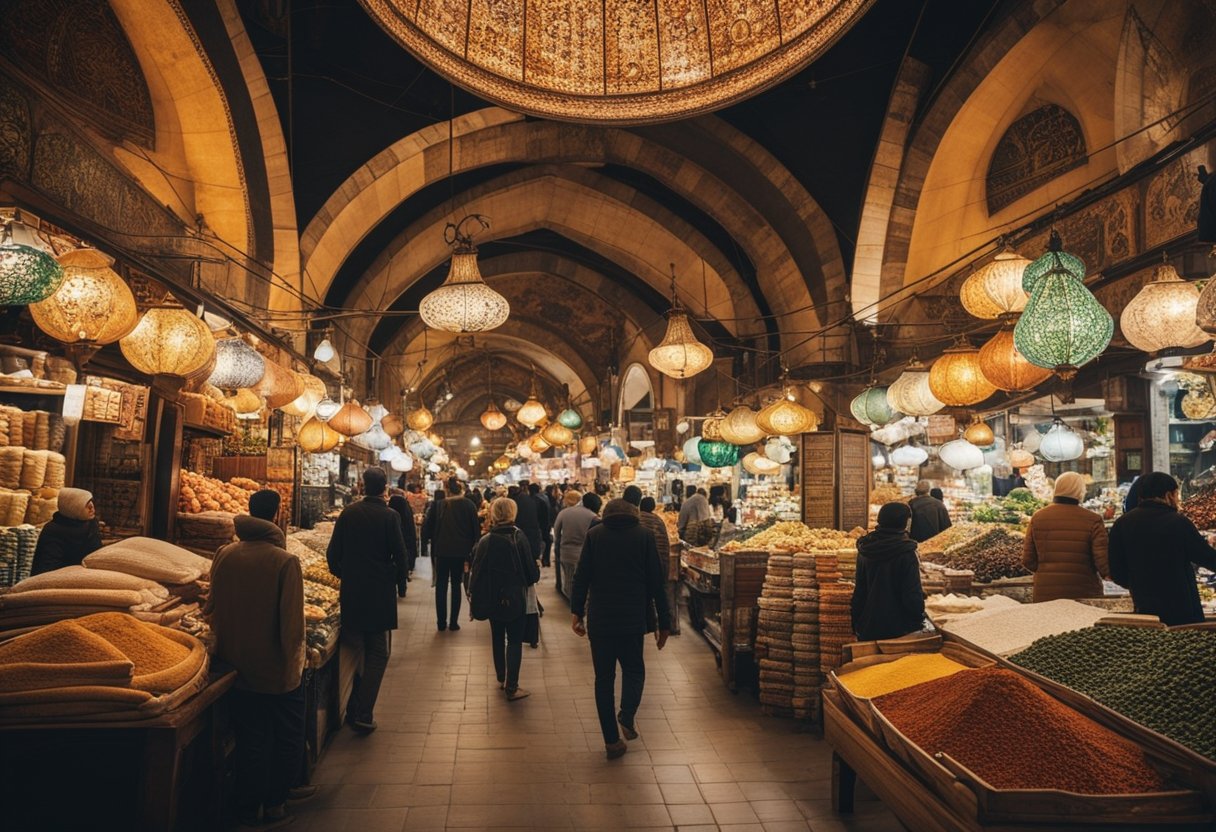
In the weaving warren of Istanbul’s bazaars, we witness a vibrant tapestry of culture that draws in travellers from around the globe. Istanbul has long been a crossroads of civilisations, and its markets are living proof, attracting a diverse audience seeking connection with its storied past and present.
The Tourist Appeal of Istanbul’s Bazaars

Istanbul’s bazaars, notably the Grand Bazaar and the Spice Market, are not just shopping destinations; they are historical landmarks that offer a sensory journey through Turkish culture. The Grand Bazaar, or Kapalı Çarşısı, holds particular fame for its size and age, housing thousands of shops with a wide array of souvenirs, from intricately designed carpets to handcrafted jewellery. The allure extends to the Spice Market, where the colours and scents of spices showcase the rich culinary traditions of Turkey.
Enthralling tourists with their maze-like corridors, each bazaar boasts a unique atmosphere; the Arasta Bazaar is smaller yet equally enchanting, often less crowded, allowing for a more leisurely experience. Its location, nestled near the Blue Mosque, further heightens its appeal, offering picturesque surroundings alongside the promise of a treasure trove of goods.
A Destination for Different Travellers
Istanbul’s markets serve as a bustling backdrop for a myriad of traveller types, whether they are history enthusiasts keen to walk through living museums or shoppers in pursuit of unique finds. Our location within these bazaars provides a prime viewpoint for observing this multitude of visitors, from curious rookie adventurers to seasoned globe-trotters.
The array of commodities available, from luxurious textiles to customised spices, ensures that there is something for every kind of shopping aficionado. It’s a place where negotiating is part of the experience, and as such, many find themselves not just purchasing products but also engaging in the rich tapestry of Istanbul’s market tradition.
Istanbul’s bazaars have successfully evolved from local commerce hubs to international centres of trade and tourism. We take pride in our heritage and relish the opportunity to share it with the world through these living emporiums. The bazaars stand as vibrant intersections where local residents and global tourists engage with our city’s thousand-year-old narrative.
The Influence of Location and Accessibility
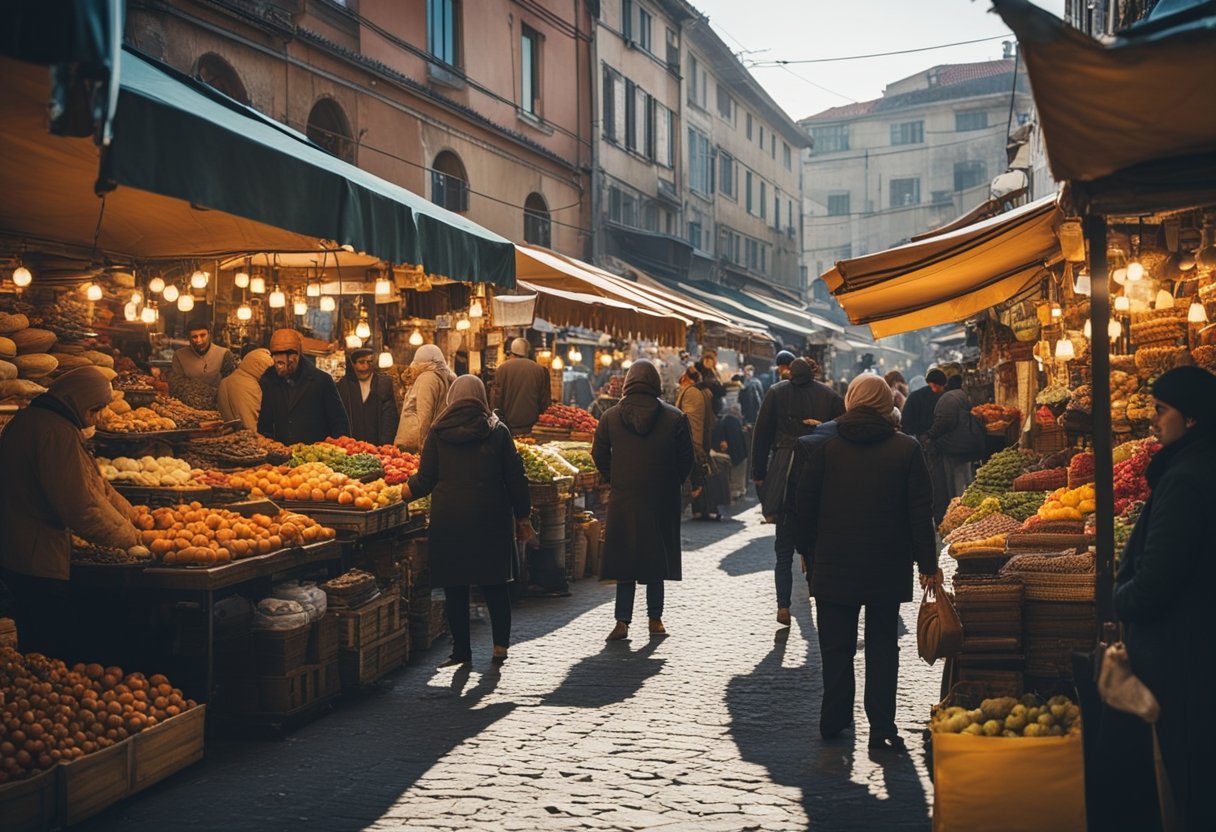
Istanbul’s bazaars have thrived through the centuries not just by chance but by strategic placement. It’s the city’s interweaving of culture and commerce, bolstered by exceptional accessibility, that makes its markets so resilient.
Central Bazaars and Neighbourhood Markets
Istanbul serves as a prime example of how location influences the prominence of a marketplace. Positioned at the crossroads of Europe and Asia, the city’s historically significant bazaars, such as the one in Beyazıt and others encompassing areas like Sultanahmet and Eminönü, attract not only locals but a large influx of tourists. Neighbourhood markets, like those in Kadıköy and Beşiktaş, integrate seamlessly into the daily lives of residents, proving essential for their daily necessities.
Markets in Bakırköy and Bahçelievler further illustrate how the surrounding community’s needs shape a bazaar’s character. Conversely, in districts like Pendik and Şişli, bazaars and markets reflect the modern and dynamic aspects of Istanbul, with a finger on the pulse of the city’s evolving trends.
Getting Around: Transport to Bazaars
Istanbul’s comprehensive transport system plays a vital role in the accessibility of its bazaars. Historical markets along İstiklal Street and in the Eminönü area are well-connected by trams and buses, facilitating easy visits for shopping or exploration. The Kadıköy markets, including those sprawling beside the Bosphorus, are accessible via ferries, embodying the city’s unique relationship with the waterways.
Furthermore, the modern Metro system extends to various parts of Istanbul, ensuring that less central locales like Şişli and Bakırköy are just a ride away for anyone looking to discover their local markets. This network of roads, rails, and maritime routes ensures that the cultural tapestry of Istanbul’s bazaars is never more than a convenient journey away.
Sustainability and Future of Trading Hubs
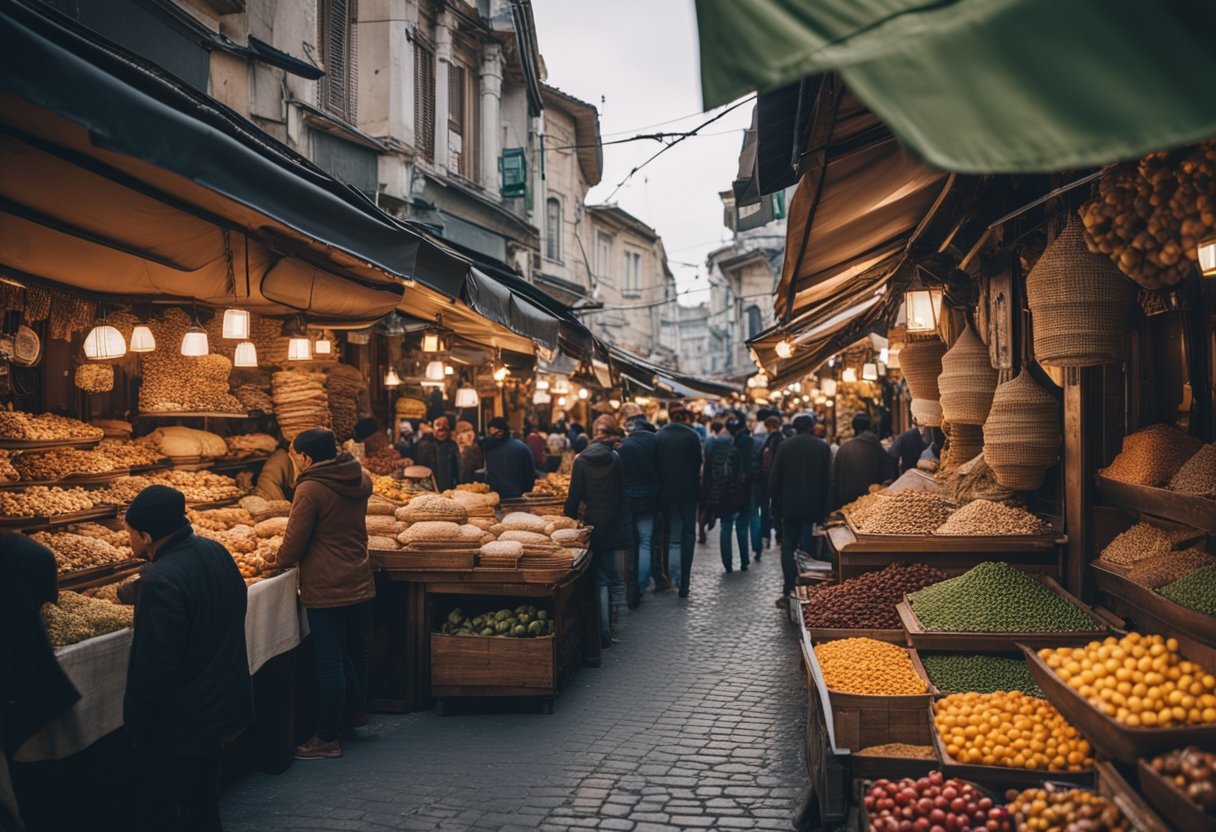
In our vibrant city, the hubs of commerce are not just places of trade; they stand as testaments to our rich history and cultural heritage. The Grand Bazaar, for example, is a beacon of tradition, sustainability, and modern significance in Istanbul’s economy.
Conservation Efforts
Our beloved Grand Bazaar, an iconic marketplace, has survived for centuries, honouring the traditions of our ancestors. Its continued existence highlights a commitment to sustainability within its walls. Conservation is paramount; efforts to preserve the integrity of this historic site are ceaseless, ensuring future generations can experience its splendour. This includes meticulous attention to restoring its structure and ensuring the bazaar remains a liveable space for traders and customers alike, blending the old with the new.
The Role of Bazaars in the Modern Economy
Bazaars like the Grand Bazaar are not just remnants of the past. They play a crucial role in our modern economy. They serve as a bridge between traditional commerce and the present-day market, integrating sustainable practices and promoting local crafts. Istanbul’s markets encourage local economic growth, tourist attraction, and cultural exchange, which are essential in a dynamic, forward-looking economy. The allure of these markets lies in their ability to adapt, offering a place where cherished tradition meets the pulse of contemporary trade.
Frequently Asked Questions

With Istanbul’s wealth of history, its markets are more than just shopping destinations; they are a vibrant testament to the city’s rich culture and heritage.
Which is the more renowned market in Istanbul, the Spice Bazaar or the Grand Bazaar?
The Grand Bazaar is generally more renowned than the Spice Bazaar, dating back to the 15th century. The Grand Bazaar is considered one of the world’s oldest and largest covered markets, boasting a vast array of goods.
What are the must-visit markets in Istanbul for a glimpse into local culture?
For a true immersion into local culture, visitors should explore the Grand Bazaar and the Spice Bazaar. Additional markets, such as the Arasta Bazaar and the vibrant street markets in various neighbourhoods of Istanbul, also provide a lively cultural experience.
Could you list the main traditional bazaars found throughout Istanbul?
Yes, the main traditional bazaars found in Istanbul are the Grand Bazaar, the Spice Bazaar, also known as the Egyptian Bazaar, the Arasta Bazaar, and the lesser-known but charming bazaars like Kadıköy Fish Market and Sahaflar Bazaar, amongst others.
What kind of merchandise is typically available at the Ortakoy Sunday market?
The Ortakoy Sunday market typically offers a wide variety of merchandise, including handmade crafts, art, textiles, and jewellery, catering to both locals and tourists looking for unique finds.
How does the bazaar culture in Istanbul reflect the city’s thousand-year history?
The bazaar culture in Istanbul reflects the city’s history through its continuity of commerce, diverse merchandise that ranges from spices to textiles synonymous with the Silk Road, and its melting pot of cultures seen in the varied goods and interactions within the bazaars.
What are the operating hours for the most popular markets in Istanbul?
The most popular markets in Istanbul, like the Grand Bazaar, generally operate from around 9 am to 7 pm but are closed on Sundays, whereas the Spice Bazaar may have similar hours but is typically open on Sundays as well.






